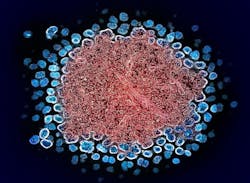Long-acting, injectable antiretroviral therapy (ART) suppressed HIV replication better than oral ART in people who had previously experienced challenges taking daily oral regimens and was found safe in adolescents with HIV viral suppression, according to two studies presented at the 2024 Conference on Retroviruses and Opportunistic Infections (CROI) in Denver. Both studies were sponsored by the National Institute of Allergy and Infectious Diseases (NIAID), part of the National Institutes of Health, in collaboration with other NIH institutes.
NIH funded this research to build on the clinical trials that underpinned the Food and Drug Administration approval of long-acting cabotegravir and rilpivirine in 2021 for people with a consistent history of viral suppression. The studies were conducted in collaboration with ViiV Healthcare and Johnson & Johnson and intended to provide evidence on the use of the drug regimen in populations for whom limited data exist.
The first large clinical trial examined the effectiveness of long-acting injectable cabotegravir and rilpivirine coupled with support to help people who had experienced barriers to consistently taking daily oral ART. Participants were randomized to receive long-acting injectable ART every four weeks or standard-of-care daily oral ART. An interim analysis of data from 294 participants showed that the chance of experiencing unsuppressed HIV was 7% among people taking long-acting ART compared to 25% among those taking daily oral ART. The likelihood of discontinuing the assigned regimen due to adverse events or experiencing unsuppressed HIV was 10% among people taking long-acting ART compared to 26% among those taking daily ART. These findings were statistically significant. The study’s primary endpoint measured the probability that participants would experience unsuppressed HIV and discontinue their ART regimen for any reason, and while findings showed a favorable trend for long-acting ART compared to daily oral ART, the effect was not statistically significant based on the study’s stringent interim analysis criteria. The study is being implemented in the United States (including Puerto Rico) through ACTG, a global NIH-funded clinical trials network focused on HIV and other infectious diseases.
A subset of participants in both the long-acting and daily ART study arms remained unsuppressed on their assigned ART regimen, and two people with unsuppressed HIV in the long-acting arm were found to have HIV resistant to integrase inhibitors—cabotegravir’s drug class. More than half of participants taking long-acting ART experienced injection-site reactions, such as pain, redness, or swelling, and one discontinued use for that reason. On February 21, 2024, NIH announced that an independent Data and Safety Monitoring Board (DSMB) recommended halting randomization and offering all eligible study participants long-acting ART based on its observed superior viral suppression of HIV. NIH accepted the DSMB’s recommendation.
A second clinical trial examined the safety of the same regimen administered every eight weeks in adolescents with HIV viral suppression. The study enrolled participants aged 12 to 17 in Botswana, South Africa, Thailand, Uganda and the United States. Of the 142 participants for whom data were available at 24 weeks, all remained virally suppressed and none experienced serious adverse events related to the drug regimen. Thirty-five percent of participants reported an injection-site reaction, the majority of which were mild and resolved within seven days. No one discontinued use of the regimen due to adverse events. As required by the study protocol, one participant discontinued study drugs due to an unintended pregnancy. They had a live birth with no complications. The drug concentrations of cabotegravir and rilpivirine in adolescents were comparable to levels generally observed in adults.

